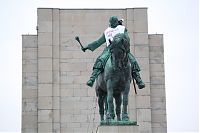Zizka in a T-shirt
 A few days ago, a group of activists (what a broad term) decided to point their finger at the Communist Party in a way that drew some attention. They dressed the Vitkov- placed statue of Jan Zizka in a t- shirt with a “I won’t bear another totalitarianism” sign printed on it. In Czech the sign is somewhat smarter, but it would be difficult to translate.
A few days ago, a group of activists (what a broad term) decided to point their finger at the Communist Party in a way that drew some attention. They dressed the Vitkov- placed statue of Jan Zizka in a t- shirt with a “I won’t bear another totalitarianism” sign printed on it. In Czech the sign is somewhat smarter, but it would be difficult to translate.
The group behind the action calls itself Decomunization, a sister term of the widely- used Denazification. No wonder they draw a parallel between the Nazi regime and the Communist one and they advocate an approach towards the Czech communists based on the German post- war strategy: banning the party and trying its main figures at court.
It’s a question of individual taste whether one likes or detests such a form, anyway it draws attention to a painful question of Czech contemporary history. The Czech society did not find a way to deal with its Communist (or Real- Socialist) past.
Firstly, the argument whether the regime may be compared to Nazism is far from resolved. Both opinions have strong advocates with powerful arguments. The question is all the more difficult depending on the way we state it: should we compare the Soviet Communism and Nazism or should we speak only about Czech Communism and Nazism? One of the difficult points is that should we take the radical way and declare the 1948- 1989 regime a system similar to Nazi terror, it would mean that nearly every family was partly involved in collaboration and the guilt would be almost unbearable.
Beside the theoretical argument there’s the physical state of things, which is what the decomunizers are complaining about.
After 1989 nobody really knew what to do about the Party and its members (there was just too many of them).The question was not resolved. It’s not only that even the most “obvious” criminals avoided punishment. The problem is there was not really any model, any road taken. The nineties suffered a split personality in this question. On one hand nothing really was done in the juristic field, on the other, major media often tended and still tend to portrait everyone who ever was a party member as a criminal. Many ordinary people felt insulted and degraded, though they personally did no harm to anyone. The power holders, in contrast, were left untouched, the Party structure staying similar, including the name (slightly changed by including Moravia). Once in several months there comes a Great Revelation that an actor or a singer we all know from the TV is on this or that list of contacts of the Czech secret police. Hardly anyone says a thing about what the person really did and why we all need to know it nearly twenty years after the Velvet Revolution. And the Party still keeps its ten percent presence in Parliament, carrying out mostly unproductive, declamatory policy and causing trouble during every coalition- building.
I don’t by any means want to summarize the whole of the problem, for this is too complicated a question. It is an unresolved, difficult one, and has been somehow marginalized in the nineties, partly because there were other problems, mainly the economy. It didn’t fade away, these things don’t fade away, they wait any number of years until they are confronted.
The dressed statue is only the latest in a line of events, which attempt to draw attention to the question, usually to the very existence of and support for the Communist Party. My problem with these would be that it is already accompanied by a radical position on the problem, so it doesn’t really provoke a debate on the nature of the regime and the majority’s complicity on the fact that it survived for forty years.
Gregory Crewdson – photographic exhibition in Rudolfinum More ‘Market - Temples’